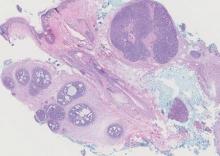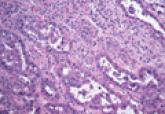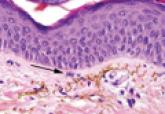Article
Onchocerciasis (River Blindness)
A 37-year-old African man presented for excision of a dermal nodule after a diagnosis of ocular onchocerciasis (river blindness). A nodule from...
Amanda F. Marsch, MD; Jeffrey B. Shackelton, MD; Dirk M. Elston, MD
Dr. Marsch is from the Department of Dermatology, University of Illinois at Chicago. Drs. Shackelton and Elston are from the Ackerman Academy of Dermatopathology, New York, New York.
The authors report no conflict of interest.
Correspondence: Amanda F. Marsch, MD, University of Illinois at Chicago, 808 S Wood St, Chicago, IL 60612 (amandafmarsch@gmail.com).

The coexistence of more than one cutaneous adnexal neoplasm in a single biopsy specimen is unusual and is most frequently recognized in the context of a nevus sebaceous or Brooke-Spiegler syndrome, an autosomal-dominant inherited disease characterized by cutaneous adnexal neoplasms, most commonly cylindromas and trichoepitheliomas. The differential diagnosis includes adenoid cystic carcinoma arising within a spiradenoma, cylindroma and spiradenoma collision tumor, microcystic change within a spiradenoma, mucinous carcinoma arising within a spiradenoma, and trichoepithelioma and spiradenoma collision tumor.
The coexistence of more than one cutaneous adnexal neoplasm in a single biopsy specimen is unusual and is most frequently recognized in the context of a nevus sebaceous or Brooke-Spiegler syndrome, an autosomal-dominant inherited disease characterized by cutaneous adnexal neoplasms, most commonly cylindromas and trichoepitheliomas.1-3 Brooke-Spiegler syndrome is caused by germline mutations in the cylindromatosis gene, CYLD, located on band 16q12; it functions as a tumor suppressor gene and has regulatory roles in development, immunity, and inflammation.1 Weyers et al3 first recognized the tendency for adnexal collision tumors to present in patients with Brooke-Spiegler syndrome; they reported a patient with Brooke-Spiegler syndrome with spiradenomas found in the immediate vicinity of trichoepitheliomas and in continuity with hair follicles.
Spiradenomas are composed of large, sharply demarcated, rounded nodules of basaloid cells with little cytoplasm (Figure 1).4 The basaloid nodules may demonstrate a trabecular architecture, and on close inspection 2 cell types—paler cells with more cytoplasm and darker cells with less cytoplasm—are distinguishable (Figure 2A). Lymphocytes often are scattered within the tumor nodules and/or stroma. In Brooke-Spiegler syndrome, collision tumors containing a spiradenomatous component in collision with trichoepithelioma are not uncommon.1 Spiradenomas in Brooke-Spiegler syndrome have been reported to contain sebaceous differentiation or foci with an adenoid cystic carcinoma (ACC)–like pattern and are known to occur as hybrid lesions of spiradenoma and cylindroma or trichoepithelioma (as in this case).
 Figure 1. Two distinct neoplasms are apparent, side by side, with an intervening hair follicle. The spirade-noma (right) is a large, sharply demarcated, rounded nodule of basaloid cells containing little cytoplasm. The trichoepithelioma (left) is composed of lobules of basaloid cells with a cribriform architecture, surrounded by a fibroblast-rich stroma. Mucin is apparent within the cystic spaces (H&E, original magnification ×2).
Figure 1. Two distinct neoplasms are apparent, side by side, with an intervening hair follicle. The spirade-noma (right) is a large, sharply demarcated, rounded nodule of basaloid cells containing little cytoplasm. The trichoepithelioma (left) is composed of lobules of basaloid cells with a cribriform architecture, surrounded by a fibroblast-rich stroma. Mucin is apparent within the cystic spaces (H&E, original magnification ×2).
In this case, 2 distinct neoplasms (spiradenoma and trichoepithelioma) are apparent, side by side, with an intervening hair follicle (Figure 1). Trichoepitheliomas, also known as cribriform trichoblastomas,5 are characterized by lobules of basaloid cells resembling basal cell carcinoma surrounded by a fibroblast-rich stroma. They often contain fingerlike projections and adopt a cribriform morphology within the tumor lobules (Figure 2B).4 Numerous horn cysts may be present, but their absence does not preclude the diagnosis. Mucin may be present within the cribriform tumor islands (Figure 2B) but not in the stroma. Characteristically, trichoepitheliomas are distinctly negative for CK7 (Figure 3), and unlike spiradenomas, they lack a myoepithelial component.6 This staining pattern in combination with the tumor’s proximity to an adjacent hair follicle makes a diagnosis of trichoepithelioma and spiradenoma collision tumor most likely and supports a clinical suspicion for Brooke-Spiegler syndrome.
| Figure 2. Spiradenomas may demonstrate a trabecular architecture, and on close inspection 2 cell types—paler cells with more cytoplasm and darker cells with less cytoplasm—are distinguishable. Lymphocytes are scattered within the tumor nodules and/or stroma (A)(H&E, original magnification ×100).The individual lobules within a trichoepithelioma can adopt a cribriform morphology, and mucin may be present within the cystic spaces (B)(H&E, original magnification ×90). |
Although spiradenomas sometimes contain cystic cavities (microcystic change), they typically are filled with finely granular eosinophilic material, not mucin, that is diastase resistant and periodic acid–Schiff positive (Figure 4).7 Spiradenomas classically stain positive with CK7 (Figure 3), epithelial membrane antigen, and carcinoembryonic antigen, and have a substantial myoepithelial component, as evidenced by the myoepithelial component staining with p63, S-100, and smooth muscle actin (SMA).7-9 The distinct lack of staining with CK7 and SMA in the tumor on the left in Figure 3 confirms that these tumors are of different lineage, rather than representing cystic change within a spiradenoma.
| Figure 3. Positive staining with CK7 can be noted in the spiradenoma (right) and negative staining is noted in the trichoepithelioma (left)(original magnification ×3). | Figure 4. Cystic cavities within a spiradenoma are filled with finely granular eosinophilic material, not mucin, that is diastase resistant and periodic acid–Schiff positive (H&E, original magnification ×30). |
Adenoid cystic carcinoma is a rare neoplasm that may occur in a primary cutaneous form, as a direct extension from an underlying salivary gland neoplasm, or rarely as a focal pattern within spiradenomas occurring both sporadically or in the context of Brooke-Spiegler syndrome.2,7 The tumor is composed of variably sized cribriform islands of basaloid to pink cells concentrically arranged around glandlike spaces filled with mucin (Figure 5A). In contrast to trichoepithelioma, ACC occurs in the mid to deep dermis, often extending into subcutaneous fat with an infiltrative border, and is not often found in close proximity to hair follicles.7 Characteristically, hyaline basement membrane–like material that is periodic acid–Schiff positive is found between the tumor cells and also surrounding the individual lobules. Immunohistochemically, ACC has a myoepithelial component that stains positive with SMA, S-100, and p63; additionally, the tumor cells express low- and high-molecular-weight keratin and demonstrate variable epithelial membrane antigen positivity.10 In the current case, the superficial location, close association with a hair follicle, and lack of staining with both CK7 (Figure 3) and SMA (not shown) make ACC arising within a spiradenoma a less likely diagnosis.
A 37-year-old African man presented for excision of a dermal nodule after a diagnosis of ocular onchocerciasis (river blindness). A nodule from...

Squamous cell carcinoma (SCC) is the second most common form of skin cancer. Pseudoglandular SCC presents most often on sun-damaged skin of...

Localized cutaneous argyria often presents as asymptomatic black or blue-gray pigmented macules in areas of the skin exposed to silver-containing...
